1878 Morazán Regular Issue
Francisco Morazán (Tegucigalpa 1792-1842) was a progressive leader and able military commander who was elected to serve as president of the Federal Republic of Central America. He enacted liberal reforms such as freedom of the press, speech and religion. He limited Roman Catholic Church power by making marriage secular and abolishing government enforced taxes to support the Catholic Church.
Validity from June 22, 1878 to January 5, 1890
printed by National Banknote Company of New York
engraved, perf 12
Production and estimated mint remainders of 1878 issue:
1c - violet 250,000 220,000
2c - brown 125,000 100,000
1/2 real -- 560,000 520,000
1 real ---- 120,000 40,000
2 reales - 70,000 50,000
4 reales - 35,000 32,000
1 peso --- 18,000 15,000
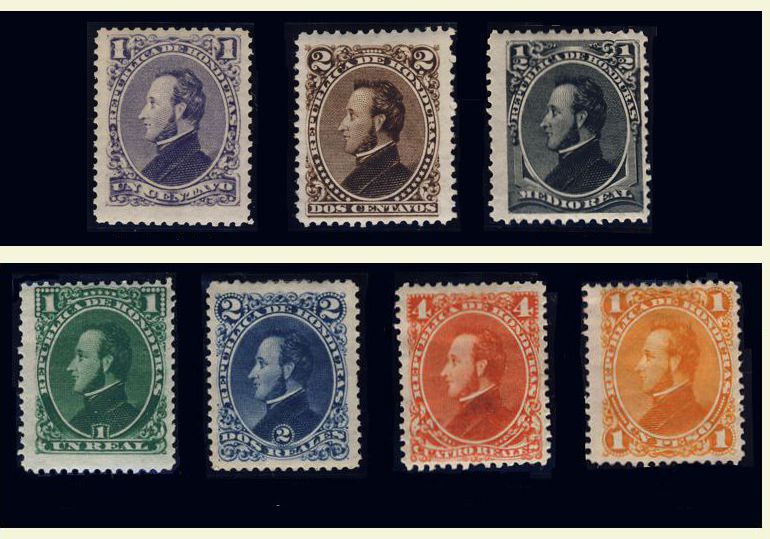 This issue was authorized by the postal guide of March 31, 1877. The minimum postal rate at the time was medio real or a bit over 6 cents. Then postal rates were lowered from half real to 5c for internal and Central American mail; and 10c for all other member nations. Thus the Morazan issue was obsolete before it was ever seen in Honduras. The government declined to surcharge this issue as it had just invalidated the surcharged 1877 issue mess. If ever there was a need for a provisional surcharge it was this Morazan issue, but none appeared.
This issue was authorized by the postal guide of March 31, 1877. The minimum postal rate at the time was medio real or a bit over 6 cents. Then postal rates were lowered from half real to 5c for internal and Central American mail; and 10c for all other member nations. Thus the Morazan issue was obsolete before it was ever seen in Honduras. The government declined to surcharge this issue as it had just invalidated the surcharged 1877 issue mess. If ever there was a need for a provisional surcharge it was this Morazan issue, but none appeared.
To date no 4r or 1p have been discovered on cover. This makes sense when you learn that the 1 peso Morazan stamp sold for 10 times the required international rate!
In 1877 the postmaster-general was named Toledo, who had a brother who held the same job in neighboring Guatemala. Both men were members of the tiny and elite privileged class. The two brothers made a business of selling remainders. The Honduran Toledo sent his brother to New York to order the new stamps from the National Bank Note Company (in 1879 merged with the ABNC). Toledo learned that American stamp dealers wanted 1c and 2c stamps to improve collector sales. He quietly added them to the official order. A million were ordered and the initial delivery of 200,000 was sent to the Honduran consul's office on Broadway, where they were sold directly to dealers. No reasonable offer refused.
A small lot was shipped to Honduras, but most of the balance of 800,000 were boxed and shipped in four lots to R. Toledo of London, of Hamburg, of Paris and of Berlin. Thus in Europe Toledo's agents disposed of the stamps to dealers at a nice profit. The infamous Gus Calman and his brother Henry bought a lot from the Toledos and went into the stamp business themselves. These were the brothers who bought out J.W.Scott in 1886 and started the Scott Stamp and Coin Company, later to be a fence for 400 Honduran "varieties" to appear. Thus, genuinely used copies with verifiable cancels are exceedingly rare, especially on cover, and the Toledo boys made mint copies, both "genuine" and "remainders" into ebay wallpaper and objects of AngloAmerican condecension..
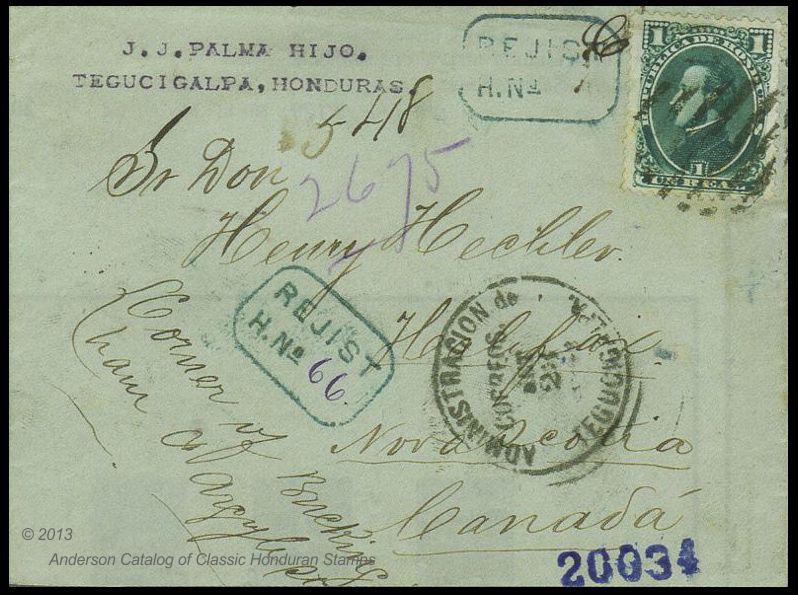 MCB cancel and ADM1 marking on the first recorded registered cover from Honduras. It was mailed from Tegus on September 23, 1882 and received in Nova Scotia a month later.
MCB cancel and ADM1 marking on the first recorded registered cover from Honduras. It was mailed from Tegus on September 23, 1882 and received in Nova Scotia a month later.
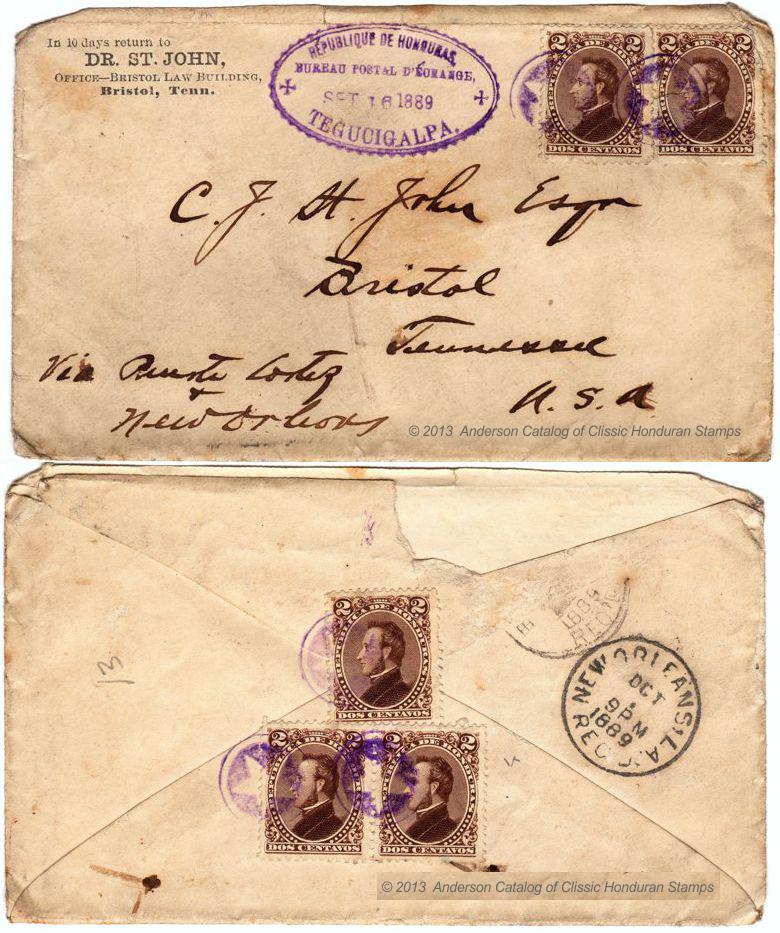 This is one of 17 covers from the priceless St. John correspondance in the Anderson collection. These were letters written between August 1889 and March 1890 to Mr. St. John by his son who was traveling in Honduras. It bears an OMSR oval cancel and the MCS star mute cancel.
This is one of 17 covers from the priceless St. John correspondance in the Anderson collection. These were letters written between August 1889 and March 1890 to Mr. St. John by his son who was traveling in Honduras. It bears an OMSR oval cancel and the MCS star mute cancel.
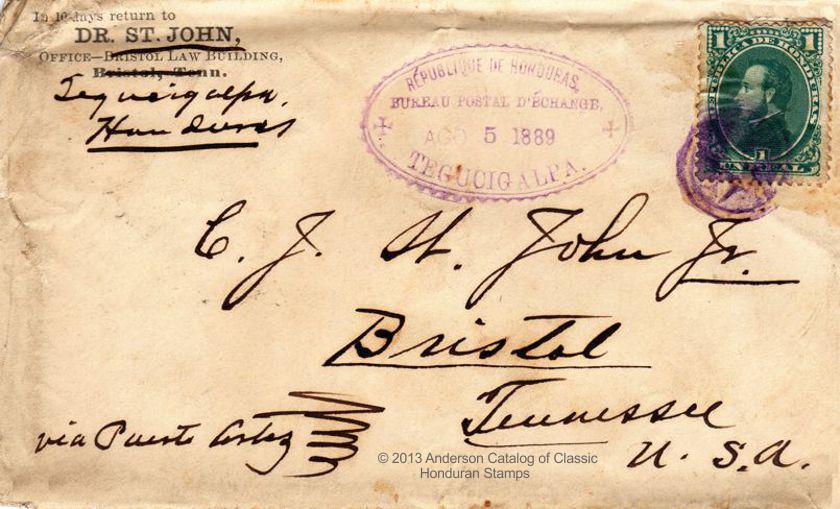 Another cover of the St. John correspondance with same cancels mailed from Tegus on August 5, 1889.
Another cover of the St. John correspondance with same cancels mailed from Tegus on August 5, 1889.
Common Cancels of the Morazán Portrait
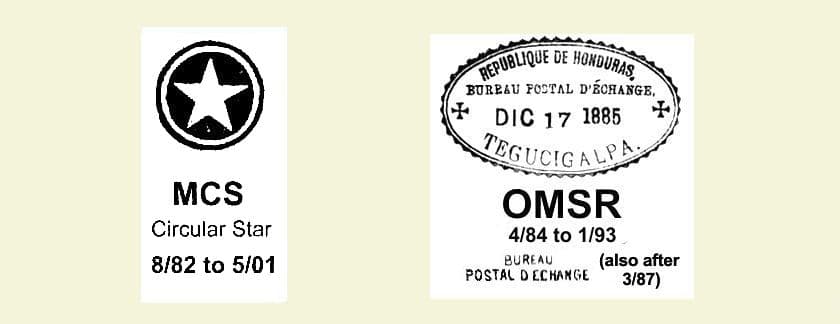
What about the 1889 "Reprints?""
The Honduran consul in New York was Seebeck's brother-in-law. He and Toledo convinced the authorities in Honduras to request a second printing of the Morazan issue all at Seebeck's expense. These were printed from the original plates by the American Banknote Company which had absorbed the National Banknote Company. They were for Seebeck's use to sell to stamp dealers. Thus, they are not forgeries. Then again, they were never distributed for postal use in Honduras and thus are not postage stamps. One cover exists but was mailed by Seebeck's agents in Honduras passing off the reprints as the 1878 stamps. Most Morazans for sale today never saw the coast of Honduras. They are monuments to American capitalism and American as apple pie. Read my lips --every last "reprint" with a cancel is a fake.
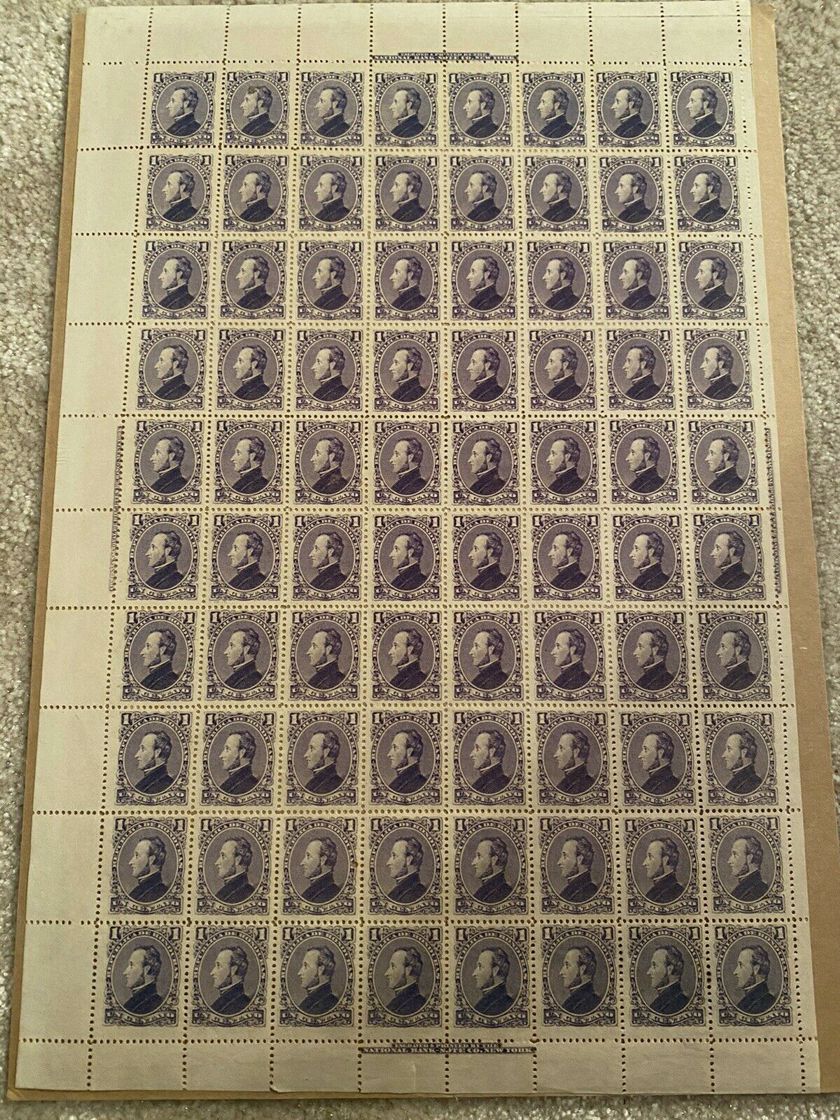 Seebeck Morazán copies flood the market and are a great introduction to fakes.
Seebeck Morazán copies flood the market and are a great introduction to fakes.
The following is an inventory of the "reprints" printed by Seebeck in New York for his personal sales.
1c violet - 495,000
2c brown - 132,000
1/2 real - 40,000
1 real - 80,000
2 reales - 37,000
4 reales - 40,000
1 peso - 26,000
The paper is thick, soft and rather highly surfaced. Gum is yellowish and thick. The printing is done more carefully so the stamps look fresher and brighter than the originals, except for the 2 centavos. The half real reprint should be distinguished by paper and gum. The color is the same.
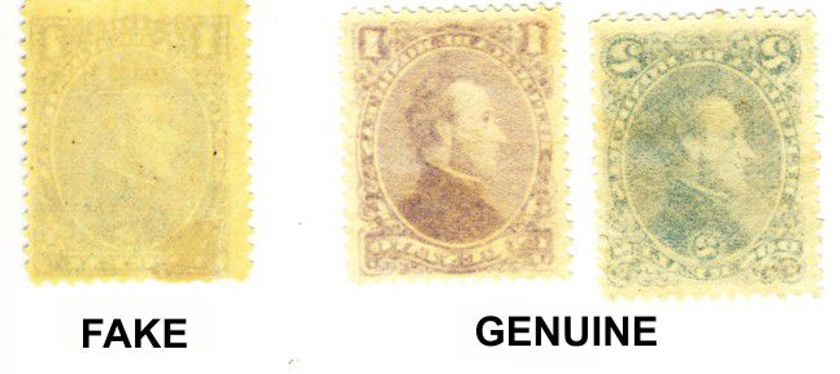
 --------------------------------------------
--------------------------------------------
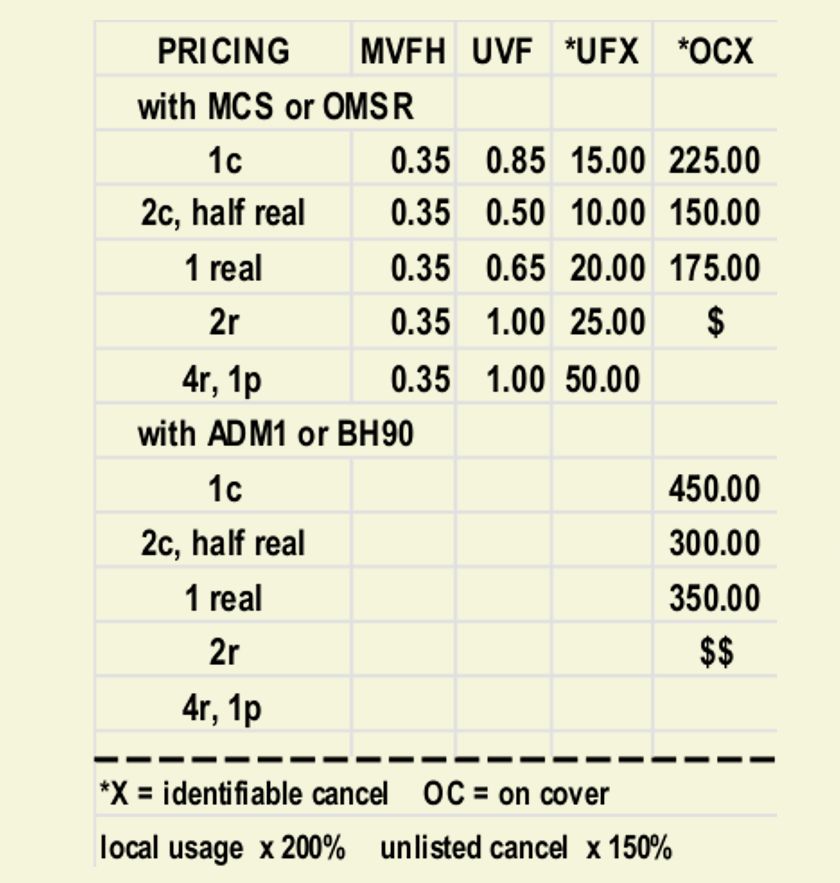
-American Architecture and Building News vol. 33 August 1891 p. 100.
-Anderson Collection.
-Fundamentals of Philately by L.N. and M. Williams. 1971 pps. 405-407.
-Guia de Honduras by F. Somoza from Tipografia Nacional 1905 p. 54.
-Honduras Report by Richard Washburn from The Oxcart, fall 1995.
-Honduras a Study of the provisionals of 1922 and 1923
by Irving Green in Billig's Handbook 1954 volume 20 pps 40-66.
-handwritten letter written by Irving Green on January 3, 1976.
-handwritten letter written by Richard Washburn in April, 1984.
10/24

